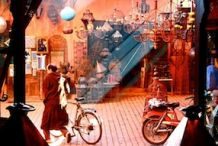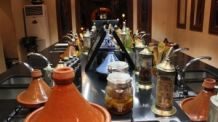Fès is the fourth largest city in Morocco and also known as one of the ancient imperial cities). It is separated into three parts, Fès el Bali (the old, walled city), Fès -Jdid (new Fes, home of the Mellah), and the Ville Nouvelle (the French-created, newest section of Fes). The Medina of Fès el Bali is believed to be the largest contiguous car-free urban area in the world. To enter the medina, you will pass through the Bab Boujeloud gate, with its decoration of blue and green faiences. You will explore the medina’s narrow streets lined with local shops and stalls of fresh fruit, mounds of spices, intricately woven Berber carpets and many other Moroccan handicrafts and home goods. Fès has two main streets, “Rue Talaa Kebira “ and the “Rue Talaa Seghira “ which are utilized as the main throughways when exploring the medina- and the mysterious maze-like streets in between.
Kissaria
The Fès medina is a labyrinth of sloping, winding alleyways are crammed full of stalls and workshops. This area is known as the famed Kissaria -the commercial center. A multitude of locally produced goods are on sale including cotton fabric, silk, brocade work, slippers, and many more. Each district in the Fès Medina produces its own specialty goods: cobalt blue enameled pottery, carpets, wrought iron … one looks on as the dyer stirs his yarns, steeped in their multitude of colors, as the tanner tramples his skins under an open sky -skins that the leather-worker will eventually adorn with fine gilt for book-binding.
Ville Nouvelle
Fès’ Ville Nouvelle is where the major government ministries of Morocco reside. Fès is a city that will impress you with its culture and stimulate your senses with its extraordinary sounds, smells and visual elements. The people of Fès, referred to as Fassis, are most hospitable. Declared a world heritage site by UNESCO Fès is also considered one of the most spiritual and religious cities in Morocco. It has stood at the heart of Moroccan civilization for over five centuries and was a major cultural and intellectual center, competing with those of Europe.

History
Fès, once a small village on the right bank of the river, was founded by Moulay Idriss in 789. Then in 808 his son, Idriss II built another town, El-Alya (High Town) on the left bank. By allowing Muslim families expelled from Cordoba, Spain and later 300 refuge families from Karaouiyine, Tunisia to use his land as a refuge, Idriss II is responsible for Fès becoming the center of Islamization and Arabization. Fès’ rich cultural history continued in 1145, when the Almohads conquered the city and helped build its prestige to become Morocco’s major economic metropolis. Fès’ development was also influenced by the Merinids who established the Fès El Jdid (new city) and raised Fes to imperial status. Fes’ achievements and prestige made it the apple of every leader’s eye. In no time it was re-conquered by the Alaouities in 1666. However, after Moulay Ismail rejected Fès as his capital, choosing Meknes instead, Fès went into a decline until the early twentieth century when the French established the Protectorate.
Current
Today Fès is a bustling city inhabited by Moroccans and Westerners. A tour of Fès is an exciting opportunity to learn about its fascinating cultural history, visit ancient landmarks and discover the ancient medina. Fès is also a great base for taking day trips to Meknes, Moulay Idriss and Voubilis/ Walili.







